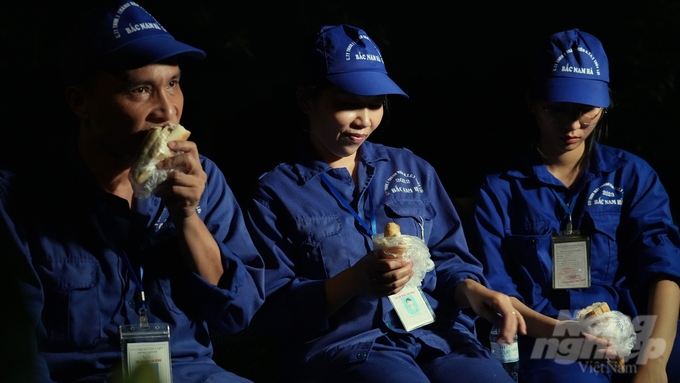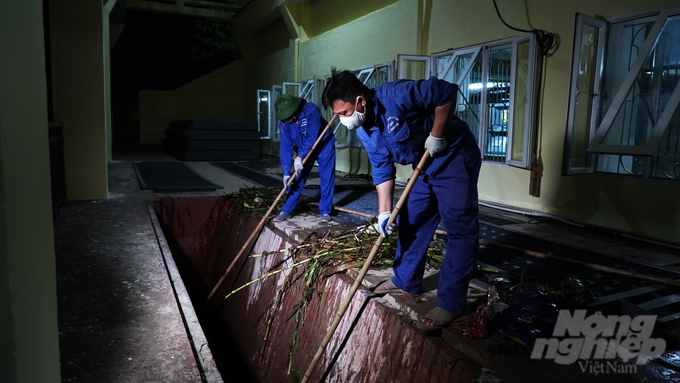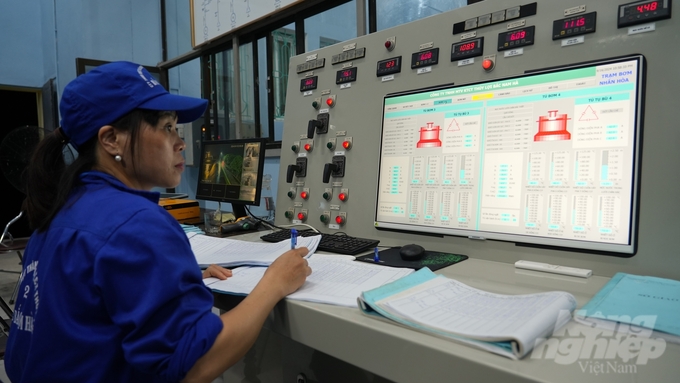November 26, 2025 | 18:41 GMT +7
November 26, 2025 | 18:41 GMT +7
Hotline: 0913.378.918
November 26, 2025 | 18:41 GMT +7
Hotline: 0913.378.918

The pumping station at 22:00 on September 16. Photo: Hung Khang.
It was 22:00. The roads we passed were deep in the water a few days ago, leading to My Trung commune, My Loc district (Nam Dinh province). Huu Bi pumping station (under Northen Nam Ha Irrigational Project Exploitation Company) stood firm in the middle of the large land.
When we were about to move, a female worker took advantage of the opportunity and delivered a quick report of flooding within the scope of the pumping station in charge. Through the introduction of Deputy Director of Northern Nam Ha Irrigation Company Tran Van Dung, we only knew who she was. The woman in her 40s was reviewing the numbers and checking the machinery. She was Tran Thanh Diep, the chief of the team operating the Huu Bi pumping station tonight.
“More than 22 years in the profession, never have I seen the Red River water rising that high. Heavy rains also caused water to flood all over the fields. That scene saddened me. Meanwhile, Northern Nam Ha irrigation system has the characteristics of relying on the pumping stations to drain,” Diep said.

Tran Thanh Diep has more than 22 years of experience in operating irrigation works. Photo: Hung Khang.
The flood water of the Red River, Day river and Dao river went up quickly and exceeding the water operation limit of the pumping stations. The Department of Irrigation has directed the Northern Nam Ha system to stop operating 12/12 pumping stations of the focal point.
Huu Bi pumping station stopped at the earliest (from 7:45 pm on September 10), and the latest was at the Nhan Hoa pumping station (from 14:00 on September 12). In particular, Huu Do pumping station stopped operation for 130 hours (more than 5 days). By September 16, the system operated all pumping stations at maximum capacity.
Thanks to the positive activities of pumping stations across the Northern Nam Ha system, until the evening of September 18, the whole system no longer has a flooded area or deep water. Due to the continuous pumping for many days, the electricity bills for the pumping stations of the system recorded a shocking number of VND 12 billion dong, and the cost of garbage diving was VND 300 million. In return, the best news is that no rice field is wiped clean, only a few areas are flooded deeply for many days leading to productivity losses.

Huu Bi pumping station plays an important role in anti-flooding. Photo: Hung Khang.
Huu Bi pumping station is located in one of the most low-lying areas of the "navel" of the Northern Delta. It is responsible for both anti-flooding and water pumping for nearly 9,000 ha in the available range of Northen Nam Ha irrigation systems. This is a large canal passing through many residential areas, so the garbage and common water hyacinths often float on the canal's surface. In every rainy season, the members of the pumping station have to clean up duckweed and garbage to open the flow. During stormy nights, the workers have much of a harder time at the scene.

Workers operate at full capacity to ensure good completion of the station's tasks. Photo: Hung Khang.
Going down to the garbage collection area, I met Lan. Hands rushing to bring the garbage into the conveyor belt, she said with a big smile, "You now get a close look at our hard job. It is the stormy season, so we all must be present at the unit. The first few days felt extremely exhausting but I gradually got used to it”.
According to Lan, while working on rainy days, it was common to encounter dead animals or trample on broken bottle glass and shells. If one did not pay attention when operating the machine, it was easy to get electric shock. Many people had to quit their jobs because they could not stand the hardship.
"I was born and raised in low-lying areas, so I understand more than anyone else the importance of the pumping station. My joy is that when I go home, people ask when the field will no longer be flooded, or when the station has a schedule to pump water in the dry season for the rice fields, and since I know the mobilization of the company, they felt delighted when I could give an answer,” said Lan.

The work requires patience because of its heavy nature. Photo: Hung Khang.
According to Tran Van Dung, implementing the official telegram and the guiding document of the Prime Minister, the Department of Irrigation (Ministry of Agriculture and Rural Development) and People's Committees of Nam Dinh and Ha Nam, the relevant units operated the focal pumping stations to buffer the removal of water before Typhoon No. 3 landed.
This was to maintain the water level at the pumping stations and help the basic control points achieve the operation processes of Northern Nam Ha, thoroughly seal the drain through the dyke, reinforce the house system, and establish shielding for machinery and equipment.

Irrigation workers stay vigilant to monitor the situation. Photo: Hung Khang.
“Typhoon No. 3 caused heavy rain, we were very concerned. To ensure drainage, workers often have to fill their bellies with instant noodles, eggs or bread. Such is hard work, but everyone does their best and tries to complete the task. Seeing the fields and crops of people not flooded is our joy,” Deputy Director Dung said.
Translated by Samuel Pham

(VAN) The Disaster Prevention Community Fund has mobilized resources to install automatic rain gauge and flood warning stations, helping localities proactively respond to natural disasters more effectively.

(VAN) Thanh Hoa province has substantial potential to supply carbon credits, opening opportunities for green economic development, enhancing agriculture and forestry value.
/2025/11/25/1741-0-nongnghiep-221736.jpg)
(VAN) The application of AI helps identify emission sources and assess air pollution developments, thereby supporting management agencies in issuing timely and appropriate control policies.

(VAN) Viet Nam will develop its carbon market not only by prioritizing transaction volumes but also by transitioning to a low-emission economy.
/2025/11/25/3413-1-171953_261.jpg)
(VAN) Experts from the Vietnam Academy of Science and Technology have conducted surveys to identify the causes of landslides in Lam Dong province and propose natural disaster prevention solutions.

(VAN) The HNT reservoir operation support system, developed by WeatherPlus in collaboration with Kyushu Electric Power, enables real-time rainfall forecasting, inflow forecasting, and flood-release simulations.

(VAN) Dr. Cao Duc Phat stated that the localization of early natural disaster warning technologies will help meet practical requirements and create favorable conditions for domestic research institutions and businesses to develop.